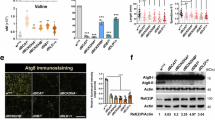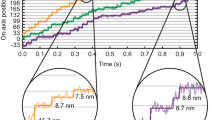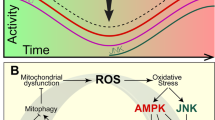Abstract
Cerebral ischemia and excitotoxic injury induce transient or permanent bioenergetic failure, and may result in neuronal apoptosis or necrosis. We have previously shown that ATP depletion and activation of AMP-activated protein kinase (AMPK) during excitotoxic injury induces neuronal apoptosis by transcription of the pro-apoptotic BH3-only protein, Bim. AMPK, however, also exerts pro-survival functions in neurons. The molecular switches that determine these differential outcomes are not well understood. Using an approach combining biochemistry, single-cell imaging and computational modeling, we here demonstrate that excitotoxic injury activated the bim promoter in a FOXO3-dependent manner. The activation of AMPK reduced AKT activation, and led to dephosphorylation and nuclear translocation of FOXO3. Subsequent mutation studies indicated that bim gene activation during excitotoxic injury required direct FOXO3 phosphorylation by AMPK in the nucleus as a second activation step. Inhibition of this phosphorylation prevented Bim expression and protected neurons against excitotoxic and oxygen/glucose deprivation-induced injury. Systems analysis and computational modeling revealed that these two activation steps defined a coherent feed-forward loop; a network motif capable of filtering any effects of short-term AMPK activation on bim gene induction. This may prevent unwanted AMPK-mediated Bim expression and apoptosis during transient or physiological bioenergetic stress.
Similar content being viewed by others
Log in or create a free account to read this content
Gain free access to this article, as well as selected content from this journal and more on nature.com
or
Abbreviations
- AKT-CA:
-
constitutively active mutant of AKT
- AMPK-CA:
-
constitutively active mutant of AMPK
- CC:
-
compound C
- CFL:
-
coherent feed-forward loop
- CGNs:
-
cerebellar granule neurons
- 6 × DBE FOXO3 promoter:
-
reporter luciferase plasmid with six copies of the FOXO family protein-binding element
- DN-FOXO3:
-
dominant-negative FOXO3
- FOXO3-6A:
-
construct with FOXO3 sequence mutated at the AMPK phosphorylation sites
- FOXO3-nuclear:
-
construct with FOXO3 sequence mutated at the AKT phosphorylation sites
- GLY:
-
glycine
- GLUT:
-
glutamate
- OGD:
-
oxygen/glucose deprivation
- PI:
-
propidium iodide
- RLUs:
-
relative luciferase counts
References
Van Den Bosch L, Van Damme P, Bogaert E, Robberecht W . The role of excitotoxicity in the pathogenesis of amyotrophic lateral sclerosis. Biochim Biophys Acta 2006; 1762: 1068–1082.
Bezprozvanny I, Mattson MP . Neuronal calcium mishandling and the pathogenesis of Alzheimer's disease. Trends Neurosci 2008; 31: 454–463.
Lee JM, Zipfel GJ, Choi DW . The changing landscape of ischaemic brain injury mechanisms. Nature 1999; 399(6738 Suppl): A7–A14.
Sattler R, Tymianski M . Molecular mechanisms of glutamate receptor-mediated excitotoxic neuronal cell death. Mol Neurobiol 2001; 24: 107–129.
Atlante A, Gagliardi S, Minervini GM, Marra E, Passarella S, Calissano P . Rapid uncoupling of oxidative phosphorylation accompanies glutamate toxicity in rat cerebellar granule cells. Neuroreport 1996; 7: 2519–2523.
Nicholls DG . Oxidative stress and energy crises in neuronal dysfunction. Ann NY Acad Sci 2008; 1147: 53–60.
Ward MW, Rego AC, Frenguelli BG, Nicholls DG . Mitochondrial membrane potential and glutamate excitotoxicity in cultured cerebellar granule cells. J Neurosci 2000; 20: 7208–7219.
Ward MW, Huber HJ, Weisova P, Dussmann H, Nicholls DG, Prehn JH . Mitochondrial and plasma membrane potential of cultured cerebellar neurons during glutamate-induced necrosis, apoptosis, and tolerance. J Neurosci 2007; 27: 8238–8249.
Weisova P, Davila D, Tuffy LP, Ward MW, Concannon CG, Prehn JH . Role of 5'-Adenosine monophosphate-activated protein kinase in cell survival and death responses in neurons. Antioxid Redox Signal 2011; 14: 1863–1876.
Hardie DG . The AMP-activated protein kinase pathway--new players upstream and downstream. J Cell Sci 2004; 117(Pt 23): 5479–5487.
Weisova P, Concannon CG, Devocelle M, Prehn JH, Ward MW . Regulation of glucose transporter 3 surface expression by the AMP-activated protein kinase mediates tolerance to glutamate excitation in neurons. J Neurosci 2009; 29: 2997–3008.
Li J, McCullough LD . Effects of AMP-activated protein kinase in cerebral ischemia. J Cereb Blood Flow Metab 2010; 30: 480–492.
Concannon CG, Tuffy LP, Weisova P, Bonner HP, Davila D, Bonner C et al. AMP kinase-mediated activation of the BH3-only protein Bim couples energy depletion to stress-induced apoptosis. J Cell Biol 2010; 189: 83–94.
Li J, Zeng Z, Viollet B, Ronnett GV, McCullough LD . Neuroprotective effects of adenosine monophosphate-activated protein kinase inhibition and gene deletion in stroke. Stroke 2007; 38: 2992–2999.
Leist M, Jaattela M . Four deaths and a funeral: from caspases to alternative mechanisms. Nat Rev Mol Cell Biol 2001; 2: 589–598.
Gilley J, Coffer PJ, Ham J . FOXO transcription factors directly activate bim gene expression and promote apoptosis in sympathetic neurons. J Cell Biol 2003; 162: 613–622.
Davila D, Torres-Aleman I . Neuronal death by oxidative stress involves activation of FOXO3 through a two-arm pathway that activates stress kinases and attenuates insulin-like growth factor I signaling. Mol Biol Cell 2008; 19: 2014–2025.
Biswas SC, Shi Y, Sproul A, Greene LA . Pro-apoptotic Bim induction in response to nerve growth factor deprivation requires simultaneous activation of three different death signaling pathways. J Biol Chem 2007; 282: 29368–29374.
Bolster DR, Crozier SJ, Kimball SR, Jefferson LS . AMP-activated protein kinase suppresses protein synthesis in rat skeletal muscle through down-regulated mammalian target of rapamycin (mTOR) signaling. J Biol Chem 2002; 277: 23977–23980.
Dormond O, Madsen JC, Briscoe DM . The effects of mTOR-Akt interactions on anti-apoptotic signaling in vascular endothelial cells. J Biol Chem 2007; 282: 23679–23686.
Brunet A, Bonni A, Zigmond MJ, Lin MZ, Juo P, Hu LS et al. Akt promotes cell survival by phosphorylating and inhibiting a Forkhead transcription factor. Cell 1999; 96: 857–868.
Essers MA, Weijzen S, de Vries-Smits AM, Saarloos I, de Ruiter ND, Bos JL et al. FOXO transcription factor activation by oxidative stress mediated by the small GTPase Ral and JNK. EMBO J 2004; 23: 4802–4812.
Culmsee C, Monnig J, Kemp BE, Mattson MP . AMP-activated protein kinase is highly expressed in neurons in the developing rat brain and promotes neuronal survival following glucose deprivation. J Mol Neurosci 2001; 17: 45–58.
Greer EL, Oskoui PR, Banko MR, Maniar JM, Gygi MP, Gygi SP et al. The energy sensor AMP-activated protein kinase directly regulates the mammalian FOXO3 transcription factor. J Biol Chem 2007; 282: 30107–30119.
Inoue E, Yamauchi J . AMP-activated protein kinase regulates PEPCK gene expression by direct phosphorylation of a novel zinc finger transcription factor. Biochem Biophys Res Commun 2006; 351: 793–799.
Gundewar S, Calvert JW, Jha S, Toedt-Pingel I, Ji SY, Nunez D et al. Activation of AMP-activated protein kinase by metformin improves left ventricular function and survival in heart failure. Circ Res 2009; 104: 403–411.
Meisse D, Van de Casteele M, Beauloye C, Hainault I, Kefas BA, Rider MH et al. Sustained activation of AMP-activated protein kinase induces c-Jun N-terminal kinase activation and apoptosis in liver cells. FEBS Lett 2002; 526: 38–42.
Cai Y, Martens GA, Hinke SA, Heimberg H, Pipeleers D, Van de Casteele M . Increased oxygen radical formation and mitochondrial dysfunction mediate beta cell apoptosis under conditions of AMP-activated protein kinase stimulation. Free Radic Biol Med 2007; 42: 64–78.
Kilbride SM, Farrelly AM, Bonner C, Ward MW, Nyhan KC, Concannon CG et al. AMP-activated protein kinase mediates apoptosis in response to bioenergetic stress through activation of the pro-apoptotic Bcl-2 homology domain-3-only protein BMF. J Biol Chem 2010; 285: 36199–36206.
Song G, Ouyang G, Bao S . The activation of Akt/PKB signaling pathway and cell survival. J Cell Mol Med 2005; 9: 59–71.
Millward TA, Zolnierowicz S, Hemmings BA . Regulation of protein kinase cascades by protein phosphatase 2A. Trends Biochem Sci 1999; 24: 186–191.
Stambolic V, Suzuki A, de la Pompa JL, Brothers GM, Mirtsos C, Sasaki T et al. Negative regulation of PKB/Akt-dependent cell survival by the tumor suppressor PTEN. Cell 1998; 95: 29–39.
Mangan S, Alon U . Structure and function of the feed-forward loop network motif. Proc Natl Acad Sci USA 2003; 100: 11980–11985.
Shen-Orr SS, Milo R, Mangan S, Alon U . Network motifs in the transcriptional regulation network of Escherichia coli. Nat Genet 2002; 31: 64–68.
Li D, Qu Y, Mao M, Zhang X, Li J, Ferriero D et al. Involvement of the PTEN-AKT-FOXO3a pathway in neuronal apoptosis in developing rat brain after hypoxia-ischemia. J Cereb Blood Flow Metab 2009; 29: 1903–1913.
Coffey ET, Smiciene G, Hongisto V, Cao J, Brecht S, Herdegen T et al. c-Jun N-terminal protein kinase (JNK) 2/3 is specifically activated by stress, mediating c-Jun activation, in the presence of constitutive JNK1 activity in cerebellar neurons. J Neurosci 2002; 22: 4335–4345.
Brunet A, Sweeney LB, Sturgill JF, Chua KF, Greer PL, Lin Y et al. Stress-dependent regulation of FOXO transcription factors by the SIRT1 deacetylase. Science 2004; 303: 2011–2015.
Ju TC, Chen HM, Lin JT, Chang CP, Chang WC, Kang JJ et al. Nuclear translocation of AMPK-{alpha}1 potentiates striatal neurodegeneration in Huntington's disease. J Cell Biol 2011; 194: 209–227.
Essafi A, Gomes AR, Pomeranz KM, Zwolinska AK, Varshochi R, McGovern UB et al. Studying the subcellular localization and DNA-binding activity of FoxO transcription factors, downstream effectors of PI3K/Akt. Methods Mol Biol 2009; 462: 201–211.
Bouillet P, Metcalf D, Huang DC, Tarlinton DM, Kay TW, Kontgen F et al. Proapoptotic Bcl-2 relative Bim required for certain apoptotic responses, leukocyte homeostasis, and to preclude autoimmunity. Science 1999; 286: 1735–1738.
Acknowledgements
This study was supported by Marie Curie IEF (PIEF-GA-2009-237765), Science Foundation Ireland (08/ IN1/ 1949), and the Health Research Board in Ireland (PHD/2007/11). We thank Dr. Hans Georg Koenig for discussions and support, Ina Woods and Sarah Cannon for excellent technical assistance, and Andreas Strasser (WEHI, Melbourne, Australia) for bim-deficient mice.
Author information
Authors and Affiliations
Corresponding author
Ethics declarations
Competing interests
The authors declare no conflict of interest.
Additional information
Edited by JM Hardwick
Supplementary Information accompanies the paper on Cell Death and Differentiation website
Rights and permissions
About this article
Cite this article
Davila, D., Connolly, N., Bonner, H. et al. Two-step activation of FOXO3 by AMPK generates a coherent feed-forward loop determining excitotoxic cell fate. Cell Death Differ 19, 1677–1688 (2012). https://doi.org/10.1038/cdd.2012.49
Received:
Revised:
Accepted:
Published:
Issue date:
DOI: https://doi.org/10.1038/cdd.2012.49
Keywords
This article is cited by
-
Primed to die: an investigation of the genetic mechanisms underlying noise-induced hearing loss and cochlear damage in homozygous Foxo3-knockout mice
Cell Death & Disease (2021)
-
Bak instead of Bax plays a key role in metformin-induced apoptosis s in HCT116 cells
Cell Death Discovery (2021)
-
Autophagy and apoptosis cascade: which is more prominent in neuronal death?
Cellular and Molecular Life Sciences (2021)
-
The dependency of autophagy and ubiquitin proteasome system during skeletal muscle atrophy
Biophysical Reviews (2021)
-
Transglutaminase-2 regulates Wnt and FoxO3a signaling to determine the severity of osteoarthritis
Scientific Reports (2020)



